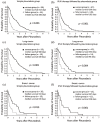Clinical outcomes of chemical pleurodesis using a minocycline
- PMID: 30945619
- PMCID: PMC6454655
- DOI: 10.1177/1753466619841231
Clinical outcomes of chemical pleurodesis using a minocycline
Abstract
Background: Pleurodesis is often used to prevent the re-accumulation of a malignant pleural effusion (MPE). Intrapleural urokinase (IPUK) therapy facilitates lung re-expansion for patients with loculated MPE or a trapped lung that allows subsequent pleurodesis. MPE management has been traditionally regarded as a symptomatic treatment. We tried to evaluate their impact on patient survival.
Methods: There were 314 consecutive patients with symptomatic MPE that underwent minocycline pleurodesis with ( n = 109) and without ( n = 205) the antecedent IPUK therapy between September 2005 and August 2015, who were recruited for the pleurodesis outcome and survival analysis.
Results: The rate of successful pleurodesis was similar between the simple pleurodesis group and the IPUK therapy group followed by the pleurodesis group (69.0% versus 70.5%; p = 0.804). The patients who succeeded pleurodesis had a longer survival rate than those who failed in either the simple pleurodesis group (median, 414 versus 100 days; p < 0.001) or the IPUK therapy followed by pleurodesis group (259 versus 102 days; p < 0.001). The survival differences remained when the lung and breast cancer patients were studied separately.
Conclusion: Successful pleurodesis translated into a better survival rate that promotes performing pleurodesis on lung re-expansion. The apparent shorter survival of the patients with loculated MPE or trapped lung, and those that did not respond to the IPUK therapy, lowered the probability of the survival benefit through the simple physical barrier by the fibrin formation to prevent the tumor spreading. The successfully induced inflammatory response by minocycline is supposed to prohibit the tumor invasion and metastasis. Further studies are warranted to clarify the mechanism and provide opportunities to develop novel therapeutic strategies.
Keywords: inflammation; intrapleural urokinase; malignant pleural effusion; pleurodesis; survival.
Conflict of interest statement
Figures



References
-
- American Thoracic Society. Management of malignant pleural effusions. Am J Respir Crit Care Med 2000; 162: 1987–2001. - PubMed
-
- Rodriguez-Panadero F. Effusions from malignancy. In: Light RW, Lee YCG, (eds) Textbook of pleural diseases. London, UK: Hodder Arnold, 2008, pp.323–337.
-
- Davies CW, Traill ZC, Gleeson FV, et al. Intrapleural streptokinase in the management of malignant multiloculated pleural effusions. Chest 1999; 115: 729–733. - PubMed
-
- Gilkeson RC, Silverman P, Haaga JR. Using urokinase to treat malignant pleural effusions. Am J Roentgenol 1999; 173: 781–783. - PubMed
-
- Maskell NA, Gleeson FV. Effect of intrapleural streptokinase on a loculated malignant pleural effusion. N Engl J Med 2003; 348: e4. - PubMed
Publication types
MeSH terms
Substances
LinkOut - more resources
Full Text Sources
Medical

